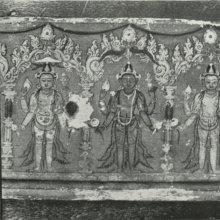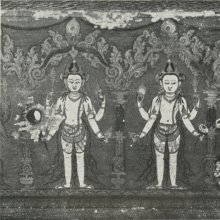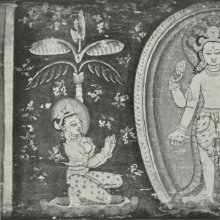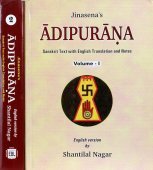Shivadharma, Shiva-dharma, Śivadharma: 8 definitions
Introduction:
Shivadharma means something in Hinduism, Sanskrit. If you want to know the exact meaning, history, etymology or English translation of this term then check out the descriptions on this page. Add your comment or reference to a book if you want to contribute to this summary article.
The Sanskrit term Śivadharma can be transliterated into English as Sivadharma or Shivadharma, using the IAST transliteration scheme (?).
Images (photo gallery)
In Hinduism
Shaivism (Shaiva philosophy)
Source: Shodhganga: Temple management in the ĀgamasŚivadharma (शिवधर्म) refers to rules or duties prescribed for the king, according to the Śaivāgamas.—Apart from the royal rituals, the āgama prescribes several duties for the king. This is called ālayadharma or śivadharma. First of these has to do with preserving the sanctity of the temple. The king then had to preserve the ritualistic tradition of the temple. Another important aspect is providing material resources for the functioning of the temple. Fourth, the king had to maintain and preserve the temple structure and precincts. Finally, the king had to ensure the collection and distribution of the temple ‘rights’ (including land tenancy, grain allowance, daily naivedya, etc.) among those who are eligible for the same.
Source: Brill: Śaivism and the Tantric Traditions1) Śivadharma (शिवधर्म) refers to the “Śaiva religion”, according to the Mṛgendrāgama Kriyāpāda verse 8.6-7.—Accordingly, “The śivadharmiṇī [initiation] is the root of success for the fruits of the Śaiva religion (śivadharma) for the individual soul. There is another [kind of śivadharmiṇī] taught without the destruction of the body, up until the dissolution of the world. The remaining one is taught to be the lokadharmiṇī, for the purpose of [attaining the eight-fold supernatural powers] starting with aṇimā after the current life, after all the bad portions [of karma] were destroyed at all reality levels”.
2) Śivadharma (शिवधर्म) refers to one of the two types of the Bhuktidīkṣā type of Initiation (dīkṣā), according to Kṣemarāja’s commentary on the Netratantra 4.1:—Accordingly, “The bhuktidīkṣā for the Sādhaka is divided into the śivadharma and laukikadharma kind”.

Shaiva (शैव, śaiva) or Shaivism (śaivism) represents a tradition of Hinduism worshiping Shiva as the supreme being. Closely related to Shaktism, Shaiva literature includes a range of scriptures, including Tantras, while the root of this tradition may be traced back to the ancient Vedas.
Purana and Itihasa (epic history)
Source: Shodhganga: The saurapurana - a critical studyŚivadharma (शिवधर्म) is described in the 10th century Saurapurāṇa: one of the various Upapurāṇas depicting Śaivism.—In the third chapter Śivadharma is described by Āditya to Manu. In this context the legend of Sudyumna is narrated.
Source: Shodhganga: Elements of Art and Architecture in the Trtiyakhanda of the VisnudharmottarapuranaŚivadharma (शिवधर्म) or Śivadharmapurāṇa refers to one of the eighteen Minor Puranas (i.e., Upapurāṇa) according to the Kūrmapurāṇa and other traditional lists of Puranic literature: a category of ancient Sanskrit texts which gives a huge contribution in the development of Indian literature.—The Upapurāṇas (e.g., śivadharma-purāṇa) can be considered as the supplements of the Mahāpurāṇas as those are mostly based on the Mahāpurāṇas. The Saurapurāṇa considers the Upapurāṇas as khilas i.e., supplements. [...] Though the numbers of Upapurāṇas are specified as eighteen, there are many important Upapurāṇas which are excluded from the lists of Upapurāṇas given by different sources.

The Purana (पुराण, purāṇas) refers to Sanskrit literature preserving ancient India’s vast cultural history, including historical legends, religious ceremonies, various arts and sciences. The eighteen mahapuranas total over 400,000 shlokas (metrical couplets) and date to at least several centuries BCE.
Languages of India and abroad
Sanskrit dictionary
Source: Cologne Digital Sanskrit Dictionaries: Aufrecht Catalogus Catalogorum1) Śivadharma (शिवधर्म) as mentioned in Aufrecht’s Catalogus Catalogorum:—from the Nandikeśvarasaṃhitā. Kāṭm. 1. Oudh. Xi, 6. Burnell. 138^b. Oppert. 6237. Ii, 5277. 7798. Śivadharmakhaṇḍa. Oppert. 7018. Quoted by Hemādri, by Mādhavācārya Oxf. 271^a, by Raghunandana and Kamalākara, in Śāktānandataraṅgiṇī Oxf. 104^a.
2) Śivadharma (शिवधर्म):—ibid.
3) Śivadharma (शिवधर्म):—in 12 chapters. Adyar Libr. 47.
Source: Cologne Digital Sanskrit Dictionaries: Monier-Williams Sanskrit-English DictionaryŚivadharma (शिवधर्म):—[=śiva-dharma] [from śiva] n. Name of a [chapter] of the Nandikeśvara-saṃhitā
[Sanskrit to German]
Sanskrit, also spelled संस्कृतम् (saṃskṛtam), is an ancient language of India commonly seen as the grandmother of the Indo-European language family (even English!). Closely allied with Prakrit and Pali, Sanskrit is more exhaustive in both grammar and terms and has the most extensive collection of literature in the world, greatly surpassing its sister-languages Greek and Latin.
Kannada-English dictionary
Source: Alar: Kannada-English corpusŚivadharma (ಶಿವಧರ್ಮ):—
1) [noun] a Śaiva sect founded in the twelfth century in Karnāṭaka.
2) [noun] its philosophy.
Kannada is a Dravidian language (as opposed to the Indo-European language family) mainly spoken in the southwestern region of India.
See also (Relevant definitions)
Partial matches: Shiva, Tarma, Dharma, Civa.
Starts with: Shivadharmaja, Shivadharmapurana, Shivadharmopapurana.
Query error!
Full-text (+51): Shivadharmopapurana, Shivadharmapurana, Upapurana, Civatarumam, Alayadharma, Vrishasarasamgraha, Nandikeshvarasamhita, Shivadharmottara, Laukikadharma, Bhuktidiksha, Shaivism, Hridaya, Laukika, Vishnuhridaya, Shivahridaya, Samdhya, Vrata, Brahmahridaya, Tapas, Yajnakrit.
Relevant text
Search found 24 books and stories containing Shivadharma, Shiva-dharma, Śiva-dharma, Siva-dharma, Śivadharma, Sivadharma, Sivadharmas; (plurals include: Shivadharmas, dharmas, Śivadharmas, Sivadharmas, Sivadharmases). You can also click to the full overview containing English textual excerpts. Below are direct links for the most relevant articles:
Studies in the Upapuranas (by R. C. Hazra)
Chapter 5.2 - The Sauradharma-purana (study)
Chapter 3.1 - The major Vaisnava-Upapuranas—Introduction
Notices of Sanskrit Manuscripts (by Rajendralala Mitra)
Expiatory Rites in Keralite Tantra (by T. S. Syamkumar)
1.8 (a). Expiatory Rites in other Saiva Treatises < [Chapter 2 - Expiatory Rites in Āgamic Literature]
Isanasivagurudeva Paddhati (study) (by J. P. Prajith)
3. Authors and Works Quoted < [Chapter 2 - A Textual analysis]
1. Works quoted by the Isanasivagurudeva-paddhati < [Chapter 5 - Isanasivagurudeva-paddhati and Saradatilaka]
8. Initial ceremonial steps for Shiva Puja (worship) < [Chapter 4 - Worship of Gods and Goddesses]
Hindu Pluralism (by Elaine M. Fisher)
Vaidika and Śaiva < [Chapter 1 - Hindu Sectarianism: Difference in Unity]
Śrīvidyā and society in Nīlakaṇṭha Dīkṣita’s Saubhāgyacandrātapa < [Chapter 2 - The Making of the Smārta-Śaiva Community of South India]
Skanda Purana (by G. V. Tagare)
Chapter 7 - Worship of the Liṅga < [Section 1 - Kedāra-khaṇḍa]
Chapter 42 - Menakā Meets Viśvāmitra < [Section 1 - Tīrtha-māhātmya]
Chapter 39 - Kedāreśvara Liṅga (Kedāra-īśvara) < [Section 1 - Prabhāsa-kṣetra-māhātmya]
Related products



